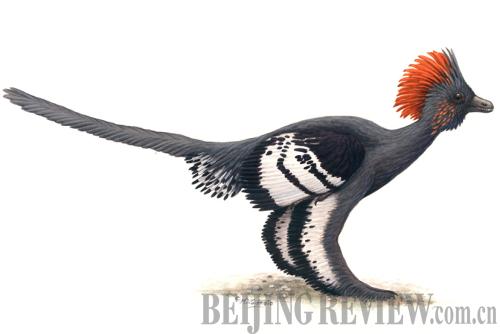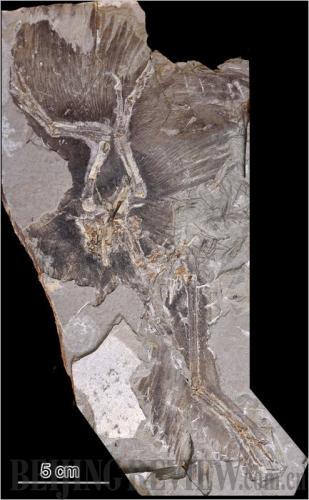|
 |
|
COLORFUL CREATURE: Scientists for the first time decode the full-body color pattern of a 155-million-year-old Anchiornis huxleyi, a kind of small-size beastly-foot class dinosaurs (COURTESY OF BEIJING MUSEUM OF NATURAL HISTORY) |
On March 10, the Beijing Museum of Natural History (BMNH) announced scientists from China and abroad had decoded the full-body color patterns of a dinosaur, a small theropod named as anchiornis huxleyi, for the first time.
These achievements, jointly obtained by scientists of BMNH and those on dinasours, modern birds, ancient birds of the Peking University, Yale University, University of Texas and University of Akron, have recently been published in Nature magazine.
"We have a gratifying achievement from studying and comparing pigment samples of dinosaurs with ancient and modern birds," said museum curator Meng Qingjin. He said they decoded the colors of the dinosaur's feathers in order to find clearer links between birds and dinosaurs.
"Anchiornis huxleyi looks like a small peacock with a woodpecker's beak and spots on its face. Its crest is reddish brown and its four wings have black and white stripes," said Li Quanguo, a paleontologist with BMNH who led the decoding project.
 |
|
The fossil of Anchiornis huxleyi (COURTESY OF BEIJING MUSEUM OF NATURAL HISTORY) | The colors of ancient creatures like dinosaurs have been a tough question perplexing paleontologists because it is hard for skins and hairs, which rot easily, to preserve original coloration even if their fossils are found.
Up to 2008, paleontologists at Yale University had discovered dinosaur fossils' feathers retained many melanosomes containing eumelanosomes. Such organelles contain pigments including eumelanosomes and phaeomelanosomes. Eumelanosomes are associated with the colors black and gray, and phaeomelanosomes produce colors ranging from reddish brown to yellow.
In 2009, scientists further confirmed feathers' color information could be preserved in fossils, providing a scientific way to ascertain full-body color patterns by analyzing pigment structures of melanosomes.
"The shapes and sizes of those melanosomes have a close link to the colors of feathers, and the finding suggests birds are likely to have descended from a small four-winged dinosaur living about 155 million years ago," said Xu Xing, a paleontologist with the Institute of Vertebrate Paleontology and Paleoanthropology of the Chinese Academy of Sciences (CAS) in Beijing.
Scientists this time chose 29 samples from feathers of an Anchiornis huxleyi specimen. By analyzing the melanosome in 29 samples using an electron microscope and spectrum technology, they found eumelanosome and phaeomelanosome, establishing a precedent for study of the inner structures of cells for more than 100 million years ago.
"The size of a melanosome is only about 1 micrometer so it is a tough job to measure its size and length. But this project provides proof for us to rebuild colors and color types," said Zhang Fucheng, a researcher with the Institute of Vertebrate Paleontology and Paleoanthropology of the CAS.
Experts even thought the finding provides a new way to research cellular and subcellular ancient lives, and living conditions, from a micro-level approach.
Meanwhile, scientists selected samples of feathers with different colors from present day birds and analyzed their melanosomes. Then they compared the two results and finally drew out full-body color patterns for Anchiornis huxleyi and verified ancient dinosaurs were colorful creatures.
"Detailed analysis of colors of dinosaur fossil samples lets us understand in a straightforward way the functions of feathers of dinosaurs and discover their process of evolution by analyzing the differences between the feathers and those of present-day birds," Li said.
In scientific circles, there are still arguments about the origins of birds, the relationship between birds and dinosaurs, and the origins of feathers and flight. The most contentious is about dinosaur's thin "hair" being a derivative of skin or being fibrous tissue within skin.
"During the evolution process, parts of vertebrates' skins may evolve into hair, furs, scales, feathers, claws and sweat glands. Like scales of fish and reptiles and fur of animals and feathers of birds, they are all skin derivatives," Zhang said.
He said scientists had found melanosomes in filamentous hair of some dinosaurs similar to feathers of birds. "Because fibrous tissues within skins do not contain melanosomes, the finding provided a new proof to a close link between dinosaurs and birds. Dinosaurs' filamentous hair also belongs to skin derivatives and finally evolved into feathers," Zhang said. | 